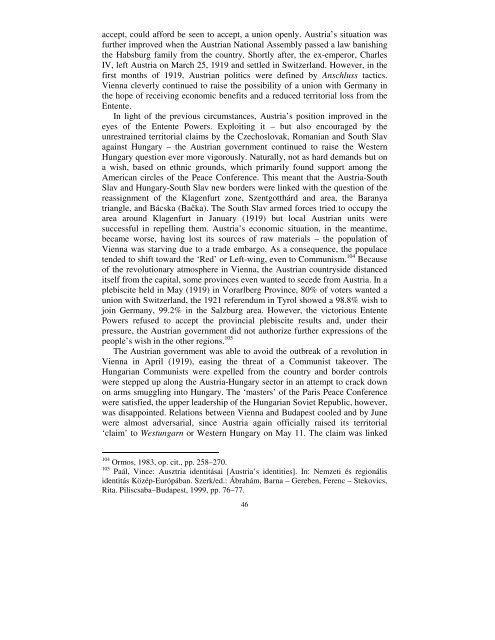The Fate of Western Hungary 1918-1921 - Corvinus Library ...
The Fate of Western Hungary 1918-1921 - Corvinus Library ...
The Fate of Western Hungary 1918-1921 - Corvinus Library ...
Create successful ePaper yourself
Turn your PDF publications into a flip-book with our unique Google optimized e-Paper software.
accept, could afford be seen to accept, a union openly. Austria’s situation was<br />
further improved when the Austrian National Assembly passed a law banishing<br />
the Habsburg family from the country. Shortly after, the ex-emperor, Charles<br />
IV, left Austria on March 25, 1919 and settled in Switzerland. However, in the<br />
first months <strong>of</strong> 1919, Austrian politics were defined by Anschluss tactics.<br />
Vienna cleverly continued to raise the possibility <strong>of</strong> a union with Germany in<br />
the hope <strong>of</strong> receiving economic benefits and a reduced territorial loss from the<br />
Entente.<br />
In light <strong>of</strong> the previous circumstances, Austria’s position improved in the<br />
eyes <strong>of</strong> the Entente Powers. Exploiting it – but also encouraged by the<br />
unrestrained territorial claims by the Czechoslovak, Romanian and South Slav<br />
against <strong>Hungary</strong> – the Austrian government continued to raise the <strong>Western</strong><br />
<strong>Hungary</strong> question ever more vigorously. Naturally, not as hard demands but on<br />
a wish, based on ethnic grounds, which primarily found support among the<br />
American circles <strong>of</strong> the Peace Conference. This meant that the Austria-South<br />
Slav and <strong>Hungary</strong>-South Slav new borders were linked with the question <strong>of</strong> the<br />
reassignment <strong>of</strong> the Klagenfurt zone, Szentgotthárd and area, the Baranya<br />
triangle, and Bácska (Bačka). <strong>The</strong> South Slav armed forces tried to occupy the<br />
area around Klagenfurt in January (1919) but local Austrian units were<br />
successful in repelling them. Austria’s economic situation, in the meantime,<br />
became worse, having lost its sources <strong>of</strong> raw materials – the population <strong>of</strong><br />
Vienna was starving due to a trade embargo. As a consequence, the populace<br />
tended to shift toward the ‘Red’ or Left-wing, even to Communism. 104 Because<br />
<strong>of</strong> the revolutionary atmosphere in Vienna, the Austrian countryside distanced<br />
itself from the capital, some provinces even wanted to secede from Austria. In a<br />
plebiscite held in May (1919) in Vorarlberg Province, 80% <strong>of</strong> voters wanted a<br />
union with Switzerland, the <strong>1921</strong> referendum in Tyrol showed a 98.8% wish to<br />
join Germany, 99.2% in the Salzburg area. However, the victorious Entente<br />
Powers refused to accept the provincial plebiscite results and, under their<br />
pressure, the Austrian government did not authorize further expressions <strong>of</strong> the<br />
people’s wish in the other regions. 105<br />
<strong>The</strong> Austrian government was able to avoid the outbreak <strong>of</strong> a revolution in<br />
Vienna in April (1919), easing the threat <strong>of</strong> a Communist takeover. <strong>The</strong><br />
Hungarian Communists were expelled from the country and border controls<br />
were stepped up along the Austria-<strong>Hungary</strong> sector in an attempt to crack down<br />
on arms smuggling into <strong>Hungary</strong>. <strong>The</strong> ‘masters’ <strong>of</strong> the Paris Peace Conference<br />
were satisfied, the upper leadership <strong>of</strong> the Hungarian Soviet Republic, however,<br />
was disappointed. Relations between Vienna and Budapest cooled and by June<br />
were almost adversarial, since Austria again <strong>of</strong>ficially raised its territorial<br />
‘claim’ to Westungarn or <strong>Western</strong> <strong>Hungary</strong> on May 11. <strong>The</strong> claim was linked<br />
104 Ormos, 1983, op. cit., pp. 258–270.<br />
105 Paál, Vince: Ausztria identitásai [Austria’s identities]. In: Nemzeti és regionális<br />
identitás Közép-Európában. Szerk/ed.: Ábrahám, Barna – Gereben, Ferenc – Stekovics,<br />
Rita. Piliscsaba–Budapest, 1999, pp. 76–77.<br />
46
















